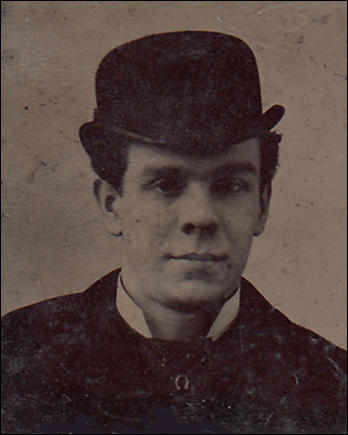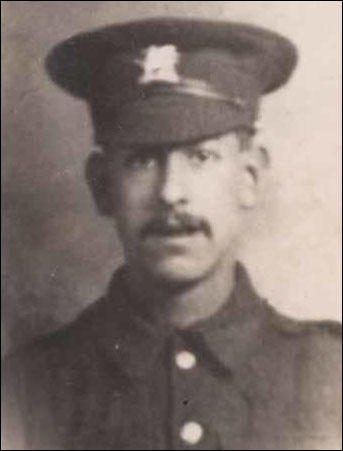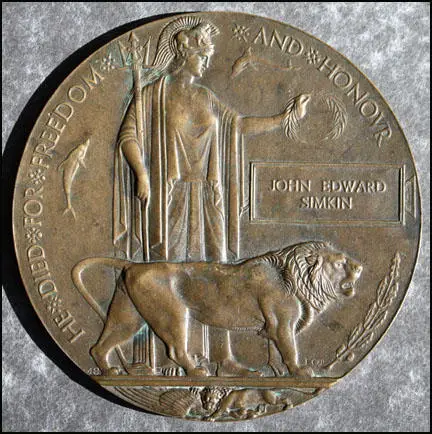The Autobiography of David Simkin
In contrast to my maternal grandmother (Mrs ‘Nell’ Hughes), my father’s mother, a woman who was known to us as ‘Mrs White’, played hardly any role in my life. In many of our family group photographs, my mum’s mother, Mrs ‘Nell’ Hughes, is present, yet I only have one photograph that features my paternal grandmother.
My paternal grandmother was born Jane Hopkins in Shoreditch, Hoxton, East London, on 12th September 1883, the daughter of Ann Brown and William Hopkins, a costermonger. When Jane was baptised at the St John the Baptist Church in Hoxton on 7th October 1883, her father, William Hopkins, gave his occupation as “Watercress Seller”, which suggests that the Hopkins family were extremely poor.

London), the father of Jane Hopkins, my paternal grandmother. William Hopkins
worked as a costermonger. The original photograph, which dates from around
1882, is a tiny ‘ferrotype’ (a photographic image on metal) and is actually
smaller in size than a standard postage stamp. A very small ‘ferrotype’ was
the cheapest kind of photographic portrait that could be had in Victorian times.”
Charles Booth in his 1902 survey entitled Life and Labour of the People in London described the district of Hoxton, where Jane Hopkins was born and raised, as follows: “The character of the whole locality is working-class. Poverty is everywhere, with a considerable admixture of the very poor and vicious... Hoxton is known for its costers and criminals.” Jane’s father, William Hopkins, was a ‘coster’, a person who sold foodstuff from a handcart in the street. Presumably, William Hopkins progressed from selling watercress from a hand-held basket to selling fruit and vegetables from a wheeled cart.
Jane Hopkins attended Sidney Road School in Homerton, a school building attached to Hackney Workhouse. Jane would have had only a basic education, leaving school at around 14 years of age. By 1901, when she was 17 years of age, Jane was working as a “tea packer” in the grocery trade.
On 23rd October, 1910, at the age of 27, Jane Hopkins married John Edward Simkin, a 29 year old “Envelope Cutter”, at St Mark’s Church, Old Street, Shoreditch. John Edward Simkin, was the son of Mary Ann Jane Budgen and John Edward Simkin senior (born 1842, Bromley-by-Bow, East London), a man who began his working life as a labourer, but at the time of his son’s birth in 1882, was employed as a “Store-Keeper” in a factory.
1939 on the day of my mum’s wedding. She was born Jane Hopkins
in Shoreditch, East London, in 1883, the daughter of a costermonger.
Jane married John Edward Simkin in 1910, when she was 27 years old.
John Edward Simkin, my paternal grandfather, was born on 14th December 1882 in the East London district of Limehouse. At the time of his marriage to Jane Hopkins, John Simkin was employed as an “Envelope Cutter” by the De La Rue Stationery Company, which had a factory in London’s Bunhill Row; walking distance from his lodgings in Norman Street, Finsbury. After their marriage, John Simkin and his wife Jane moved to a 5-room house at 27 Molewood Road, Hertford, which they shared with Jane’s mother, Mrs Ann Hopkins. At the time of the 1911 census, John Simkin, who was now using the forename ‘Edward’, was still employed as an ‘envelope cutter’ and presumably commuting to De La Rue’s factory in London. By the following year, John and Jane Simkin were living back in London.
Mrs Jane Simkin gave birth to her first child, a daughter named Elsie, early in 1912. (Elsie Simkin was to die in 1915 at the age of 3). A son, John Edward Simkin (my father) was born on 17th January 1914 in Finsbury, North London. A third child, another boy, was conceived in 1914, but it is possible that John Simkin never saw his second son because, at the outbreak of the First World War, he enlisted in the East Kent Regiment, known as ‘The Buffs’. John Simkin’s second son, William Valentine Simkin, was born on 14th February 1915. Private J. E. Simkin of the 7th Battalion, East Kent Regiment, was killed on Sunday, 29th August 1915, following an explosion near the front line in the Fricourt area of the Somme.

because he was killed in the First World War. He worked as an
‘envelope cutter’ for the De La Rue stationery company before enlisting in the
East Kent Regiment (‘The Buffs’) in 1914. He was killed in an explosion in 1915.
Documentary evidence suggests that Private John Edward Simkin of the 7th Battalion, East Kent Regiment, arrived in France in June 1915. On 21st June, 1915, Private Simkin made out a ‘Soldiers’ Will’, witnessed by two of his comrades-in-arms, Private Noel Dalton and Private Henry Dow. Private John Simkin, together with a number of other soldiers from the 7th Battalion, were sent to provide service and protection to the sappers of the 178th Tunnelling Company, who were carrying out offensive mining under enemy lines near Fricourt. The 7th Battalion War Diary recorded the following event which explained the circumstances of my paternal grandfather’s death: “News was received by the 7th Bttn. that 3 men attached to the 178th Tunnelling Company were killed when a mine was blown in on 29th August 1915.”
One of the three soldiers from ‘The Buffs’ who died was Private John Edward Simkin (Service Number G/3560); another was 19-year-old Private Noel Dalton, who had witnessed my grandfather’s will two months earlier.
Back in England, thirty-one year old Mrs Jane Simkin, who had lost her young daughter Elsie earlier that year, had now become a widow with two young children to support and care for – John Edward, a 3 year old boy, and William, a six-month-old baby.
By the end of the First World War, Mrs Jane Simkin, had found a new partner. His name was Harry White and before the end of 1918, Jane gave birth to his son, Harry White junior. Sadly, young Harry died before reaching his first birthday. Early in 1920, Jane bore Harry another child, a daughter named Lily White. Although she gave birth to two of his children and went under the name of ‘Mrs Jane White’, I have found no evidence that my paternal grandmother ever officially married Harry White. Jane was probably Harry White’s ‘common-law’ wife and they clearly cohabited for a period of time. Lily White was effectively my father’s half-sister.
By the time my paternal grandmother entered my life, she styled herself as ‘Mrs White’, a woman who had been twice widowed. I cannot establish what exactly happened to Harry White, her erstwhile partner; he might have died sometime in the 1920s. When my mum first met my father (John Edward ‘Ted’ Simkin), his mother was calling herself ‘Mrs White’ and his younger brother, William, was known locally as ‘Willie White”. It was always assumed that ‘Mrs White’ was twice widowed and, on the National Register compiled in 1939, she is shown living without a partner at 60 Garnham Street, Hackney, and is recorded as a widow. My mother recalls that ‘Mrs White’ continued to have “man friends” and remembers that her mother-in-law was in a relationship with a chimney sweep in the 1950s.

For me, my paternal grandfather, John Edward Simkin, existed only in a single photograph taken in 1915, when he was in army uniform and serving as a private in the East Kent ‘Buffs’. The only other evidence of his existence was the bronze ‘memorial plaque’ which was issued after the First World War to the next-of-kin of all British servicemen killed during the course of the war. The bronze plaque/medallion, colloquially known as the "Dead Man’s Penny", carried his name “John Edward Simkin” and, round the edge of the medallion, the legend “He Died for Freedom and Honour".
My knowledge of my paternal grandfather was minimal, but I did not know much more about my father’s mother, Mrs Jane Simkin, who was known as ‘Mrs White’ by the time I was born. I never saw my paternal grandfather, who died in 1915, but I did actually meet ‘Mrs White’, but my memory of her is hazy. I seem to remember that she was a swarthy, dark-haired, well-built woman. Because of her dark complexion and her propensity for “telling fortunes”, it was rumoured that ‘Mrs White’ was from Romany stock and that she was descended from “Spanish gypsies”. (When my brother had his DNA analysed recently, no Southern European links were found).
Mrs White’s fortune telling had a positive effect on me. She predicted that I would grow up to be ‘clever’, a forecast which my sister never tired of reminding me of in adult life. Most of the other information about paternal grandmother came from my mother. Mum told me that ‘Mrs White’ was employed as a “page folder” in a bookbinding business. Apparently, Mrs White was fond of male company and had an irrational ‘fear of trains’. That was about the extent of my knowledge concerning this shadowy figure. I spoke to my late mother’s younger sister, Stella, who is 93, and asked her about what she could remember about Mrs White.
My Aunt Stella does not paint a very flattering picture of ‘Mrs White’. Stella confirmed that ‘Mrs White’ was, physically, “a large woman”, but adds that she was usually smartly-dressed. The first image that sprang to Stella’s mind, was of this ‘big-built’ lady arriving at my mum’s house in Chingford with “a large handbag clutched under her arm”. The handbag had to be large because it contained Mrs White’s nightdress. ‘Mrs White’ would visit my mum, in the hope that she would be invited to stay the night and therefore guarantee that for a couple of days, at least, she would be “waited on, hand and foot” by my mum.
Stella relayed some information about ‘Mrs White’ which I could not have discovered from historical records. It appears that my mum was “frightened” of her mother-in-law and dreaded her occasional visits. Stella confided that ‘Mrs White’ was not a pleasant woman and was disliked by members of the Hughes family (my mother’s family). For Stella, Mrs White’s ‘fortune telling’ and superstitious ways had a very sinister character and her predictions and premonitions were more in the nature of curses. Stella regarded ‘Mrs White’ as a “wicked woman” who would terrify my mother with her “nasty” imaginary visions. Stella recounted one particular episode in which Mrs White conjured up a vision of disembodied “hands coming down the chimney”, an image that particularly disturbed my mother.
This picture of my maternal grandmother as a nasty, unpleasant woman who often behaved wickedly in a threatening manner, is rather unsettling for me. ‘Mrs White’ was, after all, the mother of my dad. Stella reassured me that Mrs White’s children were very different in character to the woman who had given birth to them. Stella remembers Lily White, my father’s half-sister, as an attractive, likeable young woman with “a lovely personality” and she has fond memories of my dad. It seems strange to me that children can, in terms of character and personality, be so different from their mother. This phenomenon is particularly apparent when I consider the contrasting nature and disposition between my mum and her mother, Mrs Elizabeth Hughes, my maternal grandmother.
